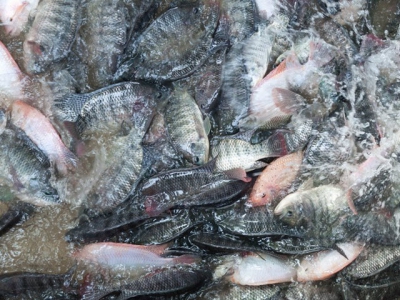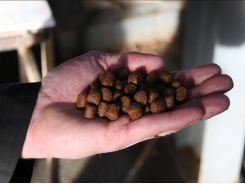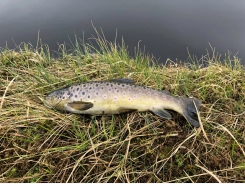Soybean oil in tilapia finishing diets may boost fish growth

Supplementing finishing diets for farmed tilapia with soybean oil may boost fish growth and the nutritional value of products generated, researchers say.
An international team of researchers from Brazil and the US explored the potential effect on Nile tilapia production when soybean oil was included in finishing diets. They published their work in the journal, Aquaculture.
“This study aimed to evaluate varying levels of soybean oil in the diet of Nile tilapia and to evaluate its effects on performance parameters, hematological parameters, fillet composition and fatty acids incorporation of the Nile tilapia during the finisher phase,” the researchers said.
Following the feeding trial, researchers found that there was a quadratic response as levels of soybean oil in fish diets increased, for daily weight gain, final weight, weight gain, carcass yield, visceral fat and the hepatosomatic index (HSI).
There was also a quadratic effect noted for total cholesterol, but no changes were found in terms of the chemical composition of fish fillets, they said.
“It is concluded that diets with soybean oil inclusion around 45.0 g kg−1, provide better growth performance of tilapia during the finishing phase,” the researchers said. “Dietary supplementation of soybean oil was effective at improving nutrition values of the meat of tilapia as well as achieving above the recommended PUFA to SFA ratio values.”
Tilapia production considerations
One of the most commonly farmed species in aquaculture is Nile tilapia, the researchers said. The fish is capable of rapid growth, large fillet yield, hardiness, lacks intramuscular bones and has been widely accepted by the market.
The production forecast for the species sees tilapia reaching about 6.6m tons of production by 2030, they added.
In general, fish provide a balanced protein along with needed fatty acids, minerals and vitamins, they said. However, there is also the option of improving the nutritional quality of a species by supplementing the diet with various fatty acids and vitamin types.
In aquafeeds, lipids provide an “essential energy source” and can be used to alter feed conversion and fish growth, the researchers said.
“In intensive fish farming, high levels of fat sources in the diet are used in order to meet the fish's energy requirements; this is done to prevent the breakdown of protein to be used as an energy source in the body.
“However, excessive energy supply can influence the animal's metabolism and cause adverse effects on growth, carcass composition with undesirable fat accumulation in the viscera and abdominal cavity.
“As well as reducing the percentage of fillet yield and the commercial value of the fish, it has been shown that the tissue lipid composition reflects the feed and can be changed by the manipulation of the diet.”
Why soybean oil in aquafeed?
Vegetable oils are considered a valuable energy source in some fish diets as they can be inexpensive and easy to find, the researchers said.
“Soybean oil is more frequently used due to its low cost when compared to other energy sources, and its overall composition meets the animal's nutritional demands,” they said. “Soybean oil has an apparent digestibility of 89.85% and 8485 kcal kg−1 of digestible energy, demonstrating that this nutrient is well used by the species O. niloticus.”
Previous research has explored the use of soybean oil in Nile tilapia diets and about 5.9% of soybean oil has been linked to improvement in carcass and fillet yield for the fish, they said. But little work has been done evaluating the use of soybean oil in finishing-phase diets.
Adding lipids to tilapia feed may be a way to lower protein levels and feed costs if the correct level can be found, the researchers said.
Feeding trial details
During the feeding trial, 270 tilapia received one of five isonitrogenous diets with varying soybean oil levels for 50 days, the researchers said.
The diets included soybean oil at 0, 15, 30, 45 and 60g per kg-1, and were designed to have about 303.8 g per kg-1 crude protein and from 12.92 to 14.34MJ kg-1 of digestible energy, they said. Soybean oil replaced cornmeal use in the diets.
Fish were assessed for weight gain during the feeding trial, survival and daily weight gain and feed conversion were calculated, they said. The diet cost rate (DCR) was also established.
A sample of fish on each diet was examined to provide carcass yield information, dressed out yield, and fillet yield and hepatosomatic index, they said. Blood samples were also collected to allow for hematological and biochemical blood parameters to be analyzed.
Additionally, fish diets and the fillets generated were checked for chemical composition, the researchers said.
Results
Increasing levels of soybean oil in the diet produced a quadratic response in fish growth performance including on daily weight gain, total weight gain, final weight, carcass yield, visceral fat index and hepatosomatic index, the researchers said.
The heaviest fish were on diets with 45g kg-1 soybean oil while the lightest were on the control diet.
However, there was not influence found on feed conversion, survival, fillet yield or dressed out yield, they added.
“It is concluded that the addition of around 45.0 g kg−1 of soybean oil to the finisher diet of Nile tilapia provides better growth performance,” they said. “Animals fed the diet, used the nutrients to produce recommended PUFA/SFA values. Dietary supplementation was also effective at improving the nutrition values of the meat.”
The diet with the lowest cost rate was fish on the 45g kg-1 soybean oil diet, the researchers said.
“The inclusion of 45.29 g kg−1 and 54.36 g kg−1 of soybean oil provided better daily weight gain and higher final tilapia weight,” they said regarding findings from quadratic regression models. “The best results for carcass yield, visceral fat and hepatosomatic index were observed with the inclusion of 37.60 kg−1, 55.17 kg−1 and 30.41 kg−1 of soybean oil respectively.”
Increasing the levels of soybean oil in the diets altered plasmatic cholesterol and triglycerides, but did not affect glucose, plasma proteins, hemoglobin or the total red cell hematocrit percentage, they said.
“According to the quadratic regression analysis, the lowest plasma cholesterol level was observed with the addition of 8.30 g kg−1 of soybean oil in the diet,” they added.
Crude protein levels tended to be lower for fish on a diet with added soybean oil, and crude fat levels tended to increase, they said.
There was also a quadratic effect found as soybean oil levels increased for the levels of several fatty acids including omega-3 fatty acids.
“Optimal finisher diet formulations not only provide good feed efficiency and growth rate, they reduce costs, and also affect the carcass and fillet quality,” the researchers said.
Source: Aquaculture
Authors: A. Godoy, O. Santos, J. Oxford, I. Melo, R. Rodrigues, D. Neu, R. Nunes, W. Boscolo
Related news
Tools

Phối trộn thức ăn chăn nuôi

Pha dung dịch thủy canh

Định mức cho tôm ăn

Phối trộn phân bón NPK

Xác định tỷ lệ tôm sống

Chuyển đổi đơn vị phân bón

Xác định công suất sục khí

Chuyển đổi đơn vị tôm

Tính diện tích nhà kính

Tính thể tích ao




 RAS to disrupt the salmon sector within the…
RAS to disrupt the salmon sector within the…  The stage is set to solve the riddle…
The stage is set to solve the riddle…